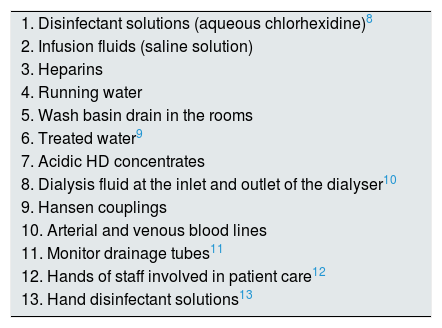Implementation of a safety culture in haemodialysis (HD) units is key.1 However, a punitive culture is responsible for limited reporting of adverse events (AEs), creating an obstacle to effective investigation. It is essential to promote a safety culture to establish strategies that ensure the provision of harm-free care. AEs are often linked to system failures, so it is more important to identify existing procedural weaknesses and report them to other units in order to adopt preventive measures, than it is to look for guilty parties.
Infectious complications of vascular access, associated with the growing use of tunnelled catheters (TCs),2 represent a common AE and correspond to an epidemic outbreak of gram-negative bacteria.3 Such a complication should be a sentinel indicator to investigate its origin and route of transmission, which is not always easy.4 We report an epidemic outbreak of bacteraemia due to Pseudomonas aeruginosa (Psa) that occurred at an HD unit in Alicante, Spain, with 164 patients, in which 11 episodes of bacteraemia were detected in two months (10 gram-negative bacteria; 9 Psa). The alert was issued after the first two cases. Various points were cultured (Table 1). Massive growth of Psa was detected in the drain of a wash basin and in a Hansen coupling. This Psa was genotypically identical to the Psa detected in the patients, suggesting that it was the source of infection and presumably reached the catheter via staff. Taps can be reservoirs for Psa infection in hospitalised patients,5 as can other sites that are not always suspected (Table 1).
Points from which samples were drawn for culture, liable to be contaminated based on scientific evidence.
| 1. Disinfectant solutions (aqueous chlorhexidine)8 |
| 2. Infusion fluids (saline solution) |
| 3. Heparins |
| 4. Running water |
| 5. Wash basin drain in the rooms |
| 6. Treated water9 |
| 7. Acidic HD concentrates |
| 8. Dialysis fluid at the inlet and outlet of the dialyser10 |
| 9. Hansen couplings |
| 10. Arterial and venous blood lines |
| 11. Monitor drainage tubes11 |
| 12. Hands of staff involved in patient care12 |
| 13. Hand disinfectant solutions13 |
HD: haemodialysis.
All cases of bacteraemia occurred in patients with TCs (33 patients: 0.18 cases of bacteraemia/TC/months of risk). Haemodynamic instability preceded bacteraemia by a week. The first three patients received empirical vancomycin and IV tobramycin and required catheter removal. All the other patients received specific treatment from the start and responded favourably. Following disinfection of water drains and the use of a disinfectant alcohol solution before and after contact with each patient,6,7 no new cases appeared after 12 months.
These outbreaks highlight the importance of active surveillance of AEs in HD, strengthening safety policies, early risk assessment and the importance of case reporting.
Please cite this article as: Arenas MD. Brote de bacteriemia por gramnegativos en pacientes portadores de catéteres tunelizados: evento adverso en las unidades de hemodiálisis. Nefrologia. 2021;41:210–211.






